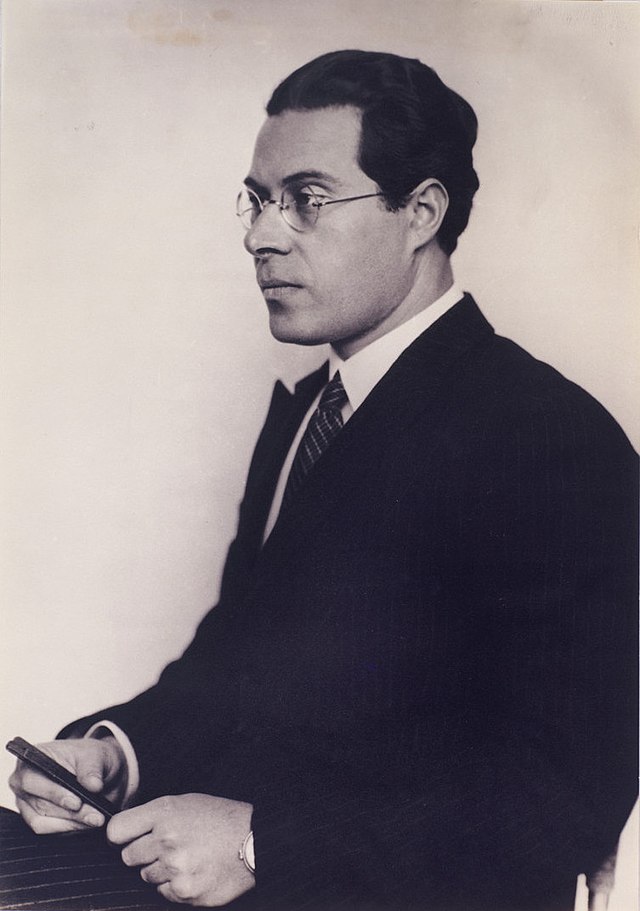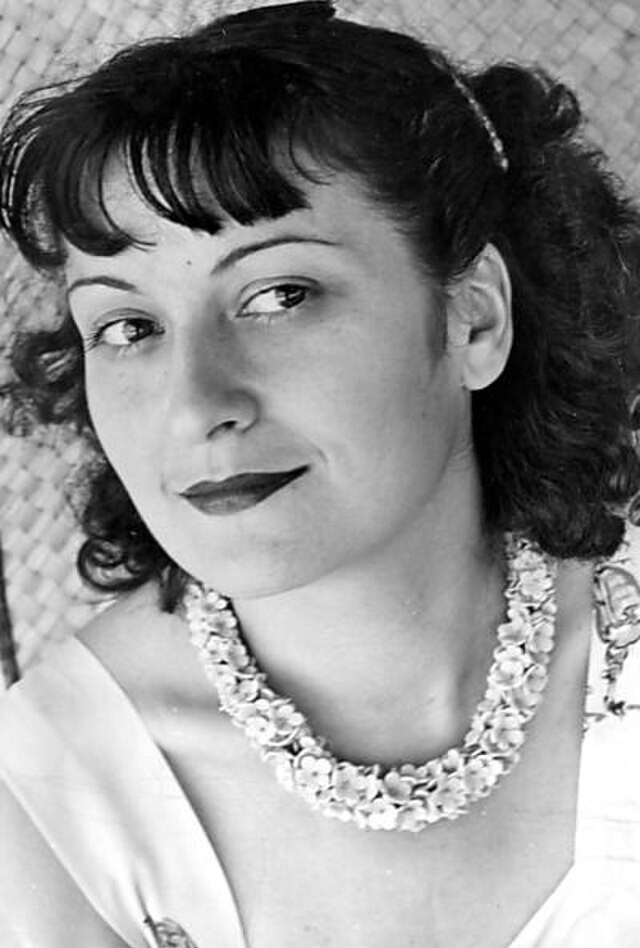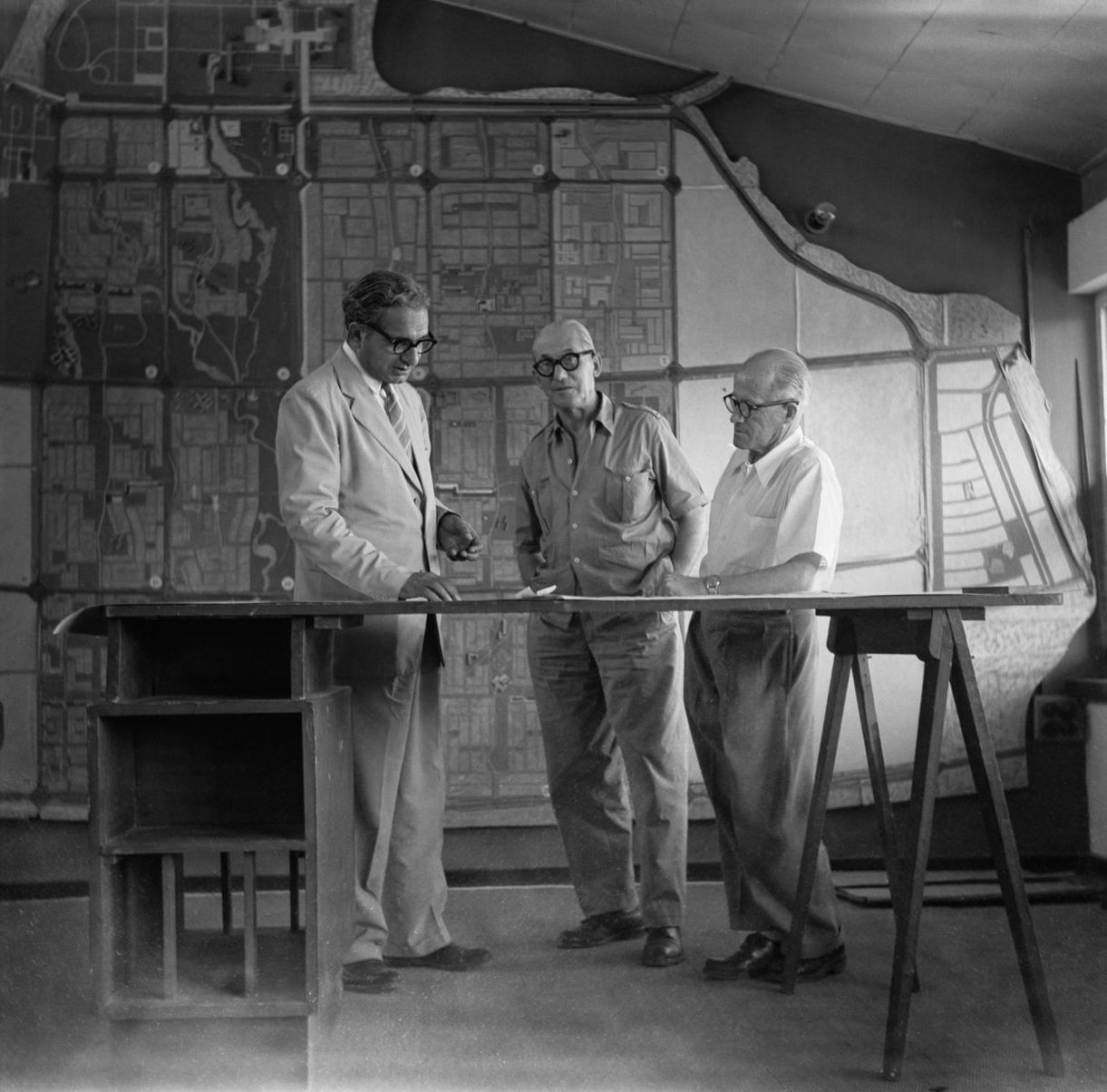
László Moholy-Nagy, photographed c. 1930.
Photo by Hugo Erfurth, via Wikimedia Commons (Public Domain).
In the chronicles of twentieth-century modernism, few figures cast a shadow as expansive and luminous as László Moholy-Nagy. He was not merely an artist confined to a single medium, but a polymath visionary whose very existence seemed to defy the conventional boundaries of creative expression. To consider Moholy-Nagy is to contemplate a prophet of modernity, a man whose “New Vision” sought to redefine the very fabric of art, design, and life itself. His unique position in the pantheon of Modernism, as an innovator equally adept in fine art and industrial design, is all the more remarkable given his largely untrained background. This absence of formal artistic tutelage, far from being a hindrance, was, in fact, a seminal liberation. It allowed him to traverse disciplines with an unburdened curiosity, to experiment without the strictures of established dogma, and to remain relentlessly innovative in every field he touched. His journey stands as a testament to the boundless potential of an unencumbered imagination, challenging the very notion of what constitutes expert artistic training and advocating implicitly for a more fluid, less constrained approach to creative development.
From War’s Forge to Bauhaus’s Dawn: Formative Years and the German Avant-Garde
László Moholy-Nagy’s life began in Borsód, Hungary, in 1895, under the name László Weisz, a family name later changed to Nagy in 1910. His early trajectory was set towards the legal profession, as he enrolled in law school in Budapest in 1913. Yet, the cataclysm of World War I would irrevocably alter this path. Voluntarily enlisting in the Austro-Hungarian Army’s artillery, he served on the Eastern Front, where the forge of conflict shaped a fundamental shift in his focus. While convalescing from a serious injury, he took up drawing and painting, documenting his wartime experiences through coloured sketches and watercolours, many sent home on postcards. This period marked the nascent stirrings of a creative spirit that would soon eclipse his academic pursuits.
Upon his discharge, Moholy-Nagy plunged into the vibrant Hungarian avant-garde scene. He joined the poetry circle of Endre Ady and exhibited his work in Budapest in 1919. His time in Szeged saw him working in a studio community, influenced by the Cubist-Expressionist works of Lajos Tihanyi and Sándor Bortnyik. A pivotal encounter came with photographer Erzsi Landau, who likely opened his eyes to the vast possibilities of the photographic medium. By 1920, Moholy-Nagy had relocated to Berlin, a city pulsating with artistic ferment. Here, he met Lucia Schulz, who would become his wife in 1921 and an essential collaborator in his early photographic experiments. This period saw the development of his first Constructivist works, including “Glasarchitektur-Bilder,” and his involvement with Erwin Piscator’s Proletarian Theatre, for which he created theatrical settings. He began writing the film scenario for “Dynamic of the Metropolis” and produced “Nickel Construction,” a work that sparked critical discourse among the avant-garde.
His burgeoning reputation caught the attention of Walter Gropius, the visionary director of the Bauhaus. In 1923, Moholy-Nagy received an invitation to teach at the renowned school of design, architecture, and applied arts. This appointment, where he headed the metal workshop, replacing Paul Klee, and taught the foundational Vorkurs (preliminary course), was more than a mere change of faculty; it marked a momentous reorientation for the Bauhaus itself. The school, initially rooted in Expressionism and handcraft, was already shifting its emphasis towards the integration of technology and design. Moholy-Nagy’s arrival served as a powerful catalyst for this transformation, accelerating its movement towards industrial design and solidifying its commitment to uniting art and technology. His educational philosophy, encapsulated in the dictum “Everybody is talented,” laid the groundwork for a revolutionary approach to art education, focusing on developing students’ natural visual gifts rather than specialised skills. His presence at the Bauhaus was not simply about teaching; it was about steering the very soul of the school towards a more technologically integrated, industrially relevant future, thereby shaping the course of modern design education globally.
The Canvas of the Unseen: Photography, Film, and the Kinetic Image
Moholy-Nagy’s restless spirit found a momentous outlet in the nascent language of photography, a medium he considered a primary vehicle for modernity. He believed that “photography means designing with light.” His most groundbreaking contribution in this realm was the photogram: cameraless photographs created by placing objects directly onto light-sensitive paper and exposing them to light. This technique, often developed in collaboration with Lucia Moholy, allowed him to explore abstract compositions, spatial relationships, and the “dematerialising effect” of light, challenging traditional modes of representation and elevating photography to a fine art. He experimented with two- and three-dimensional objects, like wire mesh or loosely-woven textiles, casting light to extract their silhouettes, structure, and texture. He saw photograms as “writing with light,” capable of “evoking an immediate optical experience” and forming “a bridge leading to a new visual creation for which canvas, paintbrush, and pigment cannot serve.”
His innovative approach extended to the dynamic combination of photography and typography, a concept he termed “Typophoto.” This fusion, evident in the Bauhausbook series he edited with Gropius and in his commercial advertising work, transformed visual communication. Moholy-Nagy understood that typography was a key agent in shaping a modern sensibility. He broke up conventional text with bold lines, juxtaposed type blocks with photographic images, and deployed fundamental typographical elements—lines, rules, circles, squares—to manage information and shape meaning through form, placement, and contrast, as much as by semantics. This understanding of visual relationships and their psychological impact demonstrated his prescient grasp of modern advertising and graphic design, influencing commercial designers in ways that resonate to this day.
The culmination of his fascination with light, motion, and the fourth dimension—time—was the Light-Space Modulator (1922–30). This kinetic sculpture, constructed from metal, glass, and plastic, was a motorised rotating device designed to project synchronised movements of light, colour, and shadow. It was, in essence, a Moholy-Nagy painting brought to life, creating the effect of photograms in motion. He developed this piece for nearly eight years, intending it for theatre and film props, as well as advertisements. Its manifestation in his avant-garde film, A Light-Play in Black-White-Gray (1930), cemented his exploration of light as a medium for both art and experience.
Underpinning these explorations was his overarching philosophy, “The New Vision” (das neue Sehen). This was not merely an aesthetic preference but an instructive and societal imperative. Moholy-Nagy championed unexpected vantage points, radical cropping, and the productive use of media to expand sensory perception. He believed that photography, especially its cameraless form, represented a new way of seeing and experiencing the world, a means of expanding human sensory perception by aligning it with the modern industrial and technological landscape. His goal was to break old habits of seeing and make individuals more critical consumers of visual culture. This perspective goes beyond simple artistic expression; it is about a fundamental shift in how humans interact with and interpret their environment. Moholy-Nagy saw art, particularly photography, as a tool for cognitive and social transformation, aiming to create a method for seeing and understanding the world imperative for navigating an increasingly complex, technologically driven society. His “New Vision” thus anticipates contemporary discussions about media literacy, critical thinking in a visually saturated world, and the role of art in shaping consciousness, positioning him as a visionary whose ideas resonate powerfully in our current digital age.
Shaping the Modern World: Art, Industrial, and Interior Design
Moholy-Nagy’s commitment to integrating art and technology led him to pioneer the use of industrial materials in his artistic practice, moving beyond traditional canvas and bronze. He embraced new materials like Plexiglas, Galalith, Trolit, and Formica in his paintings and sculptures. His “Space Modulators” exemplify this approach, as he manipulated these transparent and reflective surfaces—often heating and shaping them in his home oven—to create hybrids of painting and sculpture. These works explored light, transparency, translucency, and opacity, blurring the lines between traditional artistic categories. Notably, he deliberately used flawed Plexiglas, exploiting bubbles and imperfections from the manufacturing process, as an artistic choice that enhanced kinetic light displays and created organic forms and shadows.
This pioneering material exploration was firmly rooted in his strong advocacy for Gesamtwerk, or the total work of art. Moholy-Nagy believed in the fundamental synergy between art, technology, and education as a means to disseminate information and integrate modern elements into the industrial world. His cross-disciplinary body of work stands as a testament to this commitment, actively breaking down the artificial boundaries between fine and applied arts.
His spatial concepts extended beyond the gallery and into lived environments, notably through his contributions to interior and exhibition design. A prime example is his work for Simpson’s Piccadilly in London, a large retail store that opened in 1936. Moholy-Nagy designed much of the visual merchandising and displays for the shop, including the in-store signage and window displays. In a bold, almost performative gesture, he even incorporated three aircraft to be exhibited on the fifth floor at the store’s opening, purely to draw in curious customers and attract headlines. This demonstrated his remarkable ability to translate his avant-garde principles—his focus on light, transparency, and dynamic visual communication—into commercially successful interior and retail design. His approach was not merely about aesthetics; it was about creating an experience and driving commercial outcomes using sophisticated artistic principles. He effectively pioneered a form of experiential retail design, leveraging Constructivism’s emphasis on form and space, and his own “New Vision” of light and dynamic composition, to engage consumers and generate buzz. This foresight into the power of integrated brand experience and the blurring lines between art, design, and commerce positions his work at Simpson’s Piccadilly as a precursor to modern experiential marketing and the concept of retail spaces as curated artistic environments, powerfully influencing how brands communicate and engage with the public through physical spaces.
An American Horizon: The New Bauhaus and a Lasting Pedagogy
The rise of Nazism forced Moholy-Nagy to flee Germany in 1934, leading him through Amsterdam and London. His journey eventually brought him to Chicago in 1937, following a recommendation from Walter Gropius. Here, he was entrusted with the monumental task of establishing the “New Bauhaus,” intended as a direct American corollary to the German school. The new institution even adopted the original Bauhaus emblem as its visual brand, signalling its sanctioned affiliation.
The debut of the New Bauhaus on October 18, 1937, in Marshall Field’s unused mansion, was far from smooth. Moholy-Nagy faced considerable challenges in securing both students and faculty, and the school grappled with financial precarity. Despite these obstacles, his innovative spirit prevailed. He adapted the Bauhaus curriculum, transforming the Vorkurs into the abiding “foundation” course that remains a fixture at the Institute of Design today. Crucially, Moholy-Nagy seized this opportunity to reform the Bauhaus model, eliminating the craft-based distinctions that had, in Germany, regrettably led to gendered segregation and discrimination within workshops. Under his progressive model, the Institute established three broad departments: architecture, product design, and a “light workshop” dedicated to advertising arts. This conscious reform of the Bauhaus structure aimed to foster genuine interdisciplinary collaboration and ensure equal access to all areas of design for all students, embodying a more equitable and truly holistic approach to “designing the whole man.” His emphasis on “emotional freedom and technical experimentation” aimed to challenge students’ creativity and imagination without the constraints of traditional hierarchies. This demonstrated his progressive social vision extending beyond aesthetics into institutional practice, creating a more inclusive and less restrictive educational environment.
Despite ongoing financial difficulties, Moholy-Nagy’s leadership and tireless efforts kept the school afloat, supported by key benefactors like Walter Paepcke. The school evolved, becoming the Institute of Design in 1944, and later merging with the Illinois Institute of Technology (IIT) in 1949. This merger marked a notable milestone, as IIT became the first higher education institution in the U.S. to offer a Ph.D. in design. Though his life was tragically cut short in 1946 at the age of 51, Moholy-Nagy remained director until his death, and his teaching vision vastly shaped American design education, fostering a holistic, interdisciplinary approach that continues to influence curricula today.
The Unfinished Symphony: Moholy-Nagy’s Continuing Legacy
László Moholy-Nagy’s impact resonates across a vast array of disciplines, a testament to his widespread and lasting influence. He was an “explorer of modernity,” a “leading figure of Constructivism,” and a “pioneer of modern graphic design,” whose ideas fundamentally renewed artistic thinking, imaging, design, and art education. His work in painting, sculpture, photography, film, and industrial design consistently pushed boundaries, driven by an unwavering belief in the transformative power of light and vision.
His intellectual legacy is perhaps best encapsulated in his posthumously published book, Vision in Motion (1947). This work, an extension of his earlier The New Vision, served as a culmination of his educational principles, illustrating his belief in the “interrelation of art, technology, and science.” As Walter Gropius himself observed, The New Vision had “proved to be more than a personal credo of an artist,” becoming “a standard grammar of modern design.” Vision in Motion further cemented these ideas, providing a comprehensive view of the work conducted at the Institute of Design in Chicago and presenting a broader perspective on the interconnectedness of art and life.
Ultimately, Moholy-Nagy was a utopian artist who believed that art and technology could work hand-in-hand for the betterment of humanity, serving human needs rather than merely generating profit. His constant innovation, his commitment to social causes, and his unwavering belief in the transformative power of light and vision continue to resonate with remarkable force. His utopian vision of integrating art and technology for societal betterment was not just idealistic but acutely prescient, anticipating the modern convergence of creative disciplines with technological innovation and social responsibility. He was motivated by a commitment to social causes and a rebellion against academic limitations, believing in the moral obligation to produce for human needs. This ethical and social dimension to his artistic practice positions him as a foundational thinker for purpose-driven design. In an era increasingly grappling with the ethical implications of technology and the role of design in addressing global challenges, Moholy-Nagy’s century-old vision provides a historical blueprint for how creative fields can actively contribute to societal progress. His life was an unfinished symphony of relentless experimentation and a tireless pursuit of a better world through design, making him a figure of immense relevance in our multi- and new media age.
Further Reading
Moholy-Nagy, László. Vision in Motion. Spector Books, 2014.
Moholy-Nagy, László. The New Vision: From Material to Architecture. W. W. Norton & Company, 1938.
Hight, Eleanor. Picturing Modernism: Moholy-Nagy and Photography in Weimar Germany. MIT Press, 1995.
Botar, Oliver. Moholy-Nagy. Phaidon Press, 2006.
Haus, Andreas. Moholy-Nagy: Photographs and Photograms. Thames & Hudson, 1995.




